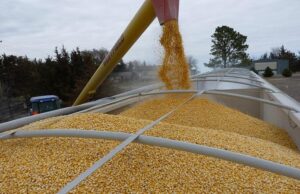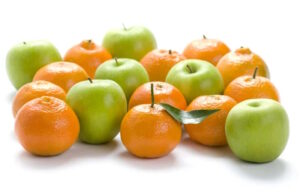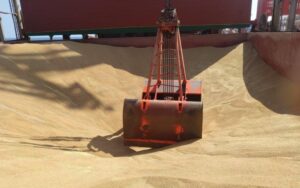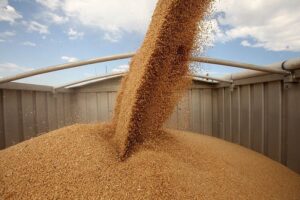
Agro-industrial holding Astarta does not expect a significant drop in income because of the ban on imports of agricultural products from Ukraine imposed by Poland and other neighboring countries, as it intends to export its products to Western European countries, representatives of the company’s board said at an online conference on Tuesday.
“We have permission to transit through these countries. Rather, our export targets are Western European countries, such as Spain, Italy, Greece and Croatia. We don’t see much risk to our revenues,” Infostrefa quoted Astarta Commercial Director Vyacheslav Chuk as saying from a conference call Tuesday.
Julia Bereshchenko, director of investor relations, expressed confidence that Astarta will be supported by expected sugar shortages in the EU and world market.
“Sugar shortages are expected not only in the EU, but worldwide as the world’s largest sugar producers, such as Brazil and India, begin to use sugar to produce ethanol. This could potentially reduce these countries’ exports,” she said.
As reported, Astarta agro-industrial holding, the largest sugar producer in Ukraine, received EUR65.16 million net profit in 2022, down 46.8% compared to 201.
The holding’s EBITDA shrank by 23.2% to EUR154.77 mln, while revenues increased by 3.8% to EUR510.07 mln.

The Hungarian Grain Association has opposed a ban on imports of agricultural products from Ukraine because it will lead to a deficit on Hungary’s domestic market and undermine efforts to curb the highest inflation rate in the European Union, Zofia Poza, secretary general of the Hungarian Grain Association, said.
“Our members are desperate and don’t support any import bans, in fact we need imports,” she told Bloomberg.
Hungary needs to import about 700,000 tons of feed corn after the 2022 crop failure, according to Hungarian grain growers.
“Eastern neighbor Ukraine will be the cheapest supplier,” she stressed.
Potsa recalled that Hungary used to only perform export control of agricultural products from Ukraine.
“Now we got a widespread ban on imports. It’s hard to call it anything other than amateurish,” the public figure said, commenting on the government’s decisions.
Poza is confident that blocking export flows will put negative pressure on food prices in Hungary, where the inflation rate exceeds 25 percent.
The Hungarian Grain Association represents the interests of flour makers, grain processors and sellers of basic food products ranging from flour and sugar to animal feed and ethanol.
Hungary has joined Poland, Slovakia and Bulgaria to impose a ban on Ukrainian grain and certain agricultural products until the end of June 2023.
While business associations in Poland are already saying that such restrictions could hurt local producers.
“Government interference in business has been a hallmark of the rule of Hungarian Prime Minister Viktor Orban, who imposed restrictions on agricultural exports in 2022 after a sharp summer decline in production,” Bloomberg writes.
The publication reminds us that the Hungarian government has also maintained a regime of controversial price controls on basic food products, which the central bank blames for inflating inflation by forcing retailers to raise the cost of other goods to make up for lost profits. Last week, the Hungarian Cabinet of Ministers announced that it would oblige supermarkets to lower the prices of basic foodstuffs as part of a new package of measures.
AGRICULTURAL PRODUCTS, BAN, Hungarian Grain Association, IMPORTS

Ukraine imported 98.735 thousand tons of citrus fruits, which is 18.6% less compared to the same period of the previous year. In monetary terms, imports decreased by 0.5% – to $95.418 million.
Imports came mainly from Turkey (54.61%), Egypt (21.24%) and Greece (9.33%).
According to STS, Ukraine also imported 1.759 thousand tons of apples, pears and quinces in the first three months of the year, which is 43.8% less than in the first quarter of 2022. In monetary terms, imports were down 3.7% to $2.433 million.
At the same time, 19.615 thousand tons of similar products were exported, which is 14.5% less than in January-March 2022. In monetary terms, exports decreased by 25% to $7.877 million.
In addition, 6.428 tons of apples, pears and quinces were imported, which is 3.9 times less than in 2021. 46.429 tons of similar products (55.7% more) were exported.

Negotiations to unblock imports of Ukrainian agricultural products to the EU between Ukraine, Poland, Slovakia, Hungary, Romania, Bulgaria and the European Commission (EC) continue. The EU offered a package of financial assistance to five countries neighboring Ukraine in exchange for the lifting of restrictive measures on Ukrainian agricultural products, informs the Ukrainian government portal.
“These countries will receive the package offered by the Commission on condition that member states cancel their unilateral measures,” EC Vice President Valdis Dombrovskis said after a meeting with representatives of Ukraine and the five EU member states that restrict the export of Ukrainian agricultural products.
According to him, the European Commission understands the importance of a joint EU approach rather than unilateral decisions, which can lead to new bans and thereby endanger the internal European market.
“The Commission has taken note of the views of the participants. We agreed to continue political consultations in the coming days to find an early solution to this problem,” Dombrovskis summarized.
The ban on the transit of Ukrainian grain through the territory of Poland and other countries was imposed last week. Poland subsequently pledged to unblock the transit of Ukrainian products through the territory of a neighboring country.

The list of agricultural products banned for import from Ukraine to Poland as of 16 April includes a broad list of grains, flour and starch, as well as, sugar, caramel, seeds for sowing, vegetables and fruits, including exotic ones, dairy products, honey, wine, livestock products and live animals, as well as dog and cat food packaged for retail sale.
According to the text of the annex to the decree of the Minister of Development and Technology of Poland Waldemar Buda dated April 15, 2023 (Interfax-Ukraine news agency has a copy), since April 16 imports of sugar maize (fresh and chilled) from Ukraine to Poland are prohibited, except for hybrids for sowing; Seeds of soft wheat and meslin, spelt, soft wheat and meslin, except for sowing, rye, barley, oats, grain sorghum, except for hybrids for sowing, buckwheat, millet, canary seed, other cereals, durum wheat: wheat and meslin flour; rye flour; wheat cereals; malt, even roasted; grain flour; and, corn, barley and oat flakes; wheat, corn, potato and other kinds of starch.
The list also included lactose, maltose, glucose, fructose in solid form; sugar syrups without added flavorings or colorings, artificial honey mixed or not with natural honey; and caramel. Also sugar beet, sugar cane, cane or beet sugar, including chemically pure sucrose, maple sugar and maple syrup. Melass obtained from the extraction or refining of sugar, beet pulp.
A range of seeds for sowing, including sweet corn hybrids, seed peas, chickpeas, crude rice, grain sorghum hybrids, linseeds; canola seeds, sunflower seeds (crushed or uncrushed; for sowing), other oilseeds and fruits; flax and hemp;
The range of fruits and vegetables prohibited for importation includes: tomatoes fresh or chilled, onions, shallots, garlic, leeks and other onion vegetables; cabbage, cauliflower, kohlrabi, leafy cabbage and similar edible vegetables; lettuce (Lactuca sativa) and chicory (Cichorium spp. ), carrots, turnips, salad beets, goatweed, celery, radishes and similar edible root vegetables, fresh or refrigerated. Also, cucumbers and gherkins, fresh or refrigerated; leguminous vegetables, peeled or unpeeled, fresh or refrigerated; nuts; fresh and dried bananas; fresh figs; pineapples; avocados; guavas mangoes and mangosteens; citrus fruits; table grapes, fresh; melons (including watermelons); papaya; apples, pears and quinces, fresh apricots, cherries, peaches (including nectarines), plums, other fruits.
It is prohibited to import not only raw vegetables, but also steamed or cooked in water, frozen, canned, dried. Under the ban are jams, marmalades, marmalades, fruit purees; wine, including grape juice and grape must; wine made from fresh grapes, including fortified wines; fresh grapes, except table grapes; vinegar.
The list includes a wide range of animal products: beef, veal, live animals of domestic species of cattle, except purebred farm animals; meat of cattle, fresh or chilled; beef frozen, salted, in brine, dried or smoked; Meat or meat by-products meal and meal; other prepared or preserved meat; live stock – thoroughbred breeding animals; preserved meat; by-products and offal; poultry meat and offal; Pig fat, meat and edible by-products of domestic pigs, sausages and similar products of meat, meat by-products or blood; swine fat (including lard); prepared products or preserves of the liver of any animal except goose or duck; pigs; mutton and goat meat; lambs (under one year of age), live sheep, except purebred breeding animals and lambs; sheep and goat meat; live swine; chilled and frozen swine meat; horses, including purebred breeding animals.

Ukraine in January-March this year, Ukraine reduced the import of nickel ores and concentrates in physical terms by 97.4% compared to the same period last year – up to 7,238 thousand tons.
According to statistics released by the State Customs Service (SCS), in monetary terms, imports of nickel ores decreased by 98% to $257,000 during the period.
Imports were from Guatemala (100% of shipments in monetary terms).
In 1Q2023, like in 1Q2022, Ukraine did not export or re-export this commodity.
As Ukrainian News earlier reported, in 2022, Ukraine reduced the imports of nickel ores and concentrates by 71.9% YoY to 346,719 tons. In monetary terms, imports of nickel ores decreased by 73.8% to $15.428 million. Imports were from Guatemala (100% of deliveries in monetary terms).
For 2022, like in 2021, Ukraine did not export or re-export this product.
Ukraine imports nickel ore from Pobuzhsky Ferronickel Plant (PFK, part of Solway Group).
PFC processes about 1.2 million tons of ore per year.